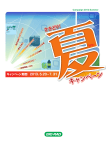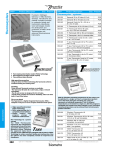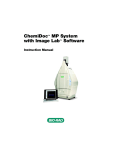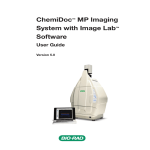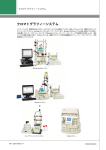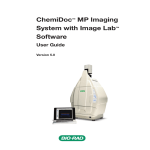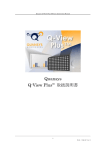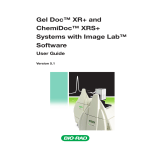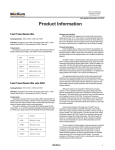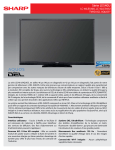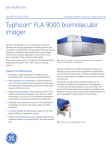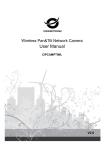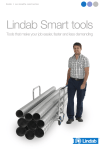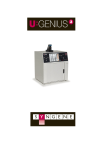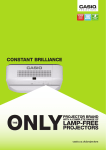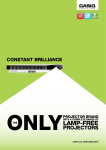Download ChemiDoc™ XRS+ Imager - Bio-Rad
Transcript
Imaging 7 3 9 6 13 2 9 4 9 8 6 16 17 8 11 2 14 2 5 11 12 11 4 8 6 11 8 5 9 7 14 17 5 11 3 13 2 15 4 1 5 6 15 15 2 7 4 8 1 3 12 11 9 3 18 1 2 6 3 3 3 1 5 8 5 8 3 8 9 2 5 15 16 2 7 9 2 16 8 15 8 6 2 6 16 13 5 7 8 11 11 9 15 5 15 2 17 9 1 14 16 7 4 2 9 14 11 15 3 11 1 18 6 11 7 11 15 12 13 7 15 ChemiDoc™ XRS+ Imager Effortless and Accurate Imaging and Analysis for Gels and Blots Solve Complex Biological Questions with Simple and Reliable Imaging For more than two decades, Molecular Imager® systems from Bio-Rad have been widely recognized and trusted high-quality imaging instruments. Whether your research includes routine imaging of chemiluminescent western blots, SDS-PAGE, or PCR products for diagnostics or therapeutic development — the ChemiDoc XRS+ imaging system will meet your needs. Designed for ease of use and ability to support a wide array of applications, it is a perfect fit for individual laboratories or multiuser core facilities. Quality standards of engineering and manufacturing make the system adaptable to academic or biopharmaceutical laboratories. Thousands of researchers over the years have published images acquired with the ChemiDoc XRS system in journal articles and grant proposals and established a record of reliability and excellence for the system. What the ChemiDoc XRS+ System Can Do for You: Automated workflow from image to results Makes your blot and gel imaging and analysis quick and effortless ■■ ■■ ■■ Allows any user to repeat the same workflow in exactly the same way Automated image capture ■■ ■■ The ChemiDoc XRS+ system is flexible and easy to use and supports other detection methods including fluorescence and colorimetry. It is the ideal complement to your electrophoresis, purification, and PCR systems, enabling image analysis and documentation of western blots, protein and DNA gels, and other sample types. Produces beautiful pictures of your blots and gels elivers quantitative analysis of your protein and D DNA samples Automated image optimization ■■ Delivers image data that is always optimized and reproducible without imaging artifacts ■■ The ChemiDoc XRS+ system enables direct digital visualization of chemiluminescent western blots for accurate images of accumulated signal from the chemiluminescent reaction. It provides reliable quantitative data for characterizing your samples reproducibly. Eliminates the need for training liminates the need to use costly and E undependable X-ray film techniques Automated image analysis Produces reports with data organized the way you want ■■ ■■ Minimizes time from lab work to presentations Immun-Star™ WesternC™ chemiluminescent detection ChemiDoc XRS+ System Applications Nucleic Acid Protein Gel ElectrophoresisElectrophoresis Blotting Ethidium bromide Coomassie Blue Chemiluminescent SYBR® Green Copper stain Colorimetric SYBR® Safe Zinc stain Qdots 525 SYBR® Gold Flamingo™ fluorescent gel stain SYBR® Safe stain Qdots 565 GelGreenOriole™ stain Qdots 625 GelRed Silver stain CY2 Fast Blast™ DNA stain Coomassie Fluor Orange Alexa Fluor 488 SYPRO Ruby DyLight 488 KryptonFluorescein Coomassie Brilliant Blue R-250 stain Oriole™ stain Qdot blot ChemiDoc XRS+ System Is Powered with Image Lab™ Software Fast Results from a Completely Automated Workflow The ChemiDoc XRS+ system is controlled by Image Lab software to automatically and reproducibly generate blot and gel images. Image Lab software is fast, taking you from blot to printed results in seconds. Your results are visible with a single click of the mouse. Image Lab software eliminates the guesswork in imaging. You won’t have to perform tedious repetitive steps to find the right focus setting. You won’t have to guess which exposure times will best visualize the bands of interest. Image calculations and corrections are done automatically for your application. Whether you are working with protein gels, nucleic acid gels, blots, or your own customized imaging application, the ChemiDoc XRS+ system will select the proper settings for optimum detection conditions of the stain, label, or light-emitting substrate in use. Automated workflow for any application. You also won’t need to set aside time for training new users; the system and the software are easy to use and work together from setup to finish. Imaging and image analysis can become the simplest work in the laboratory. Simple and Reproducible Image Capture Place your gel or blot on the ChemiDoc XRS+ imager’s sample tray and run your protocol: Your work is done in just one step. Design and save protocols for the imaging steps in your experiments and Image Lab software will run the protocols exactly the same way every time. The protocol feature negates variability in results due to different people operating the imaging system. When a new project is related to an existing one, you can reuse the previously created protocol by revising its parameters and renaming it. Image Lab software lets you devote your valuable time to research and discovery instead of to wondering if you used your imaging system properly. Results and Reports In addition to printing a picture of your gel or blot for your records, Image Lab software creates and prints reports of your experimental data. Any part of the report can be copied into popular document processing applications such as Adobe Acrobat and Microsoft Word, PowerPoint, or Excel files. To include a 3-D view of your gel or blot, copy it using the Snapshot tool, and paste it into your presentation slide. High quality, good-looking reports are easy to produce with the combined power of the ChemiDoc XRS+ system and Image Lab software. Lane profiles depict band intensity and represent quantities of sample components separated in a gel. Tutorials With Image Lab software, you don’t need previous imaging experience to produce optimal gel and blot images. Detailed tutorials are accessible via the toolbar and start-up page to acquaint you with all of the Image Lab software capabilities. It’s that easy to use Image Lab to generate the data and reports that you need. Please look at the other tutorials for more detailed explanations of other Image Lab features. When an analysis parameter is changed, the results tables are updated instantly to reflect the new data. Tutorials for novice users. 12 3 9 5 8 2 8 3 9 2 11 1 18 Immunodetection 6 11 Sophisticated Software 3 1 Automated workflows — the entire workflow (image capture, 11 is recorded in a protocol file. Protocols15 results, report) can be edited, resaved, reused, and shared among multiple 13 7 users. Allows 100% repeatability of the workflow and ensures optimized image data and analysis specific to the selected application. — Image Lab software’s proprietary algorithms calibrate the system at setup for an automatic focused image at any zoom level. Eliminates user error and the need for manual camera adjustments to obtain an image, leading to higher image quality. Auto focus Auto camera aperture control — you do not have to focus, nor adjust aperture settings. Only adjust the zoom to position sample. Allows you to quickly image across different applications with different aperture setting requirements. Flat fielding — flat fielding calibrations are performed for each application automatically. Delivers image data that is always optimized and reproducible without imaging artifacts for superior image uniformity and quantification. Increased image resolution — decreases pixelation when images are cropped or zoomed. Allows smooth, clean images at any zoom level. 7 12 15 Chemiluminescent Detection Use the signal accumulation mode (SAM) of the ChemiDoc XRS+ system to record the time course of development of the chemiluminescent reaction. ■■ Eliminate the guesswork often involved with single event film capture of blot signals ■■ Simplify chemiluminescent digital imaging During the live acquisition, the ChemiDoc XRS+ system records progressive image development, allowing you to: ■■ Visualize the accumulated chemiluminescent signal at multiple time points and capture the image ■■ Customize acquisition time and the number of images taken ■■ Save and analyze each image while the next image is being captured, even before the series is complete Automatic digital capture of chemiluminescent blot signals is efficient. ■■ Eliminate the chemical use and disposal problems involved with film developing ■■ The self-contained lighttight enclosure means you don’t need a separate darkroom ■■ For a more detailed comparison of digital detection with the ChemiDoc XRS+ system and analog detection with film, refer to bulletin 5809. Limit of Detection of Film and ChemiDoc XRS+ System 300,000 ChemiDoc XRS+ system 250,000 Chemiluminescence, RU 16 6 5 X-ray film 200,000 150,000 100,000 50,000 0 500 250 125 62.5 31.25 15.62 7.81 3.9 1.95 0.98 Human serum volume, pL X-ray film (300 sec exposure) Images can be zoomed in without losing resolution. ChemiDoc XRS+ system (60 sec exposure) — no need to export images to another program such as Photoshop image editing software to change the dpi before importing for publication. You can now define your desired resolution within Image Lab software. Comparison of chemiluminescent western blot detection on X-ray film and with the ChemiDoc XRS+ system. Blots of twofold serial dilutions of human serum were probed with rabbit anti-human transferrin polyclonal antibodies. A 1/1,000 dilution of human serum was used to make the twofold serial dilutions. A 300 sec exposure on film does not reach the same limit of detection that is reached by a 60 sec exposure in the ChemiDoc XRS+ system. Greater export functionality Accurate Quantitation Visualized The ChemiDoc XRS+ system can perform accurate quantitative detection with high resolution and sensitivity on a wide variety of samples. A Chemiluminescent and Colorimetric Detection Combined in a Single Blot C Chemiluminescence D Visible marker Chemiluminescence image from sample merged with visible marker A 1.5 3.0 6.0 30 40 100 200 370 750 B C Chemiluminescent ELISA arrays. The Quansys Biosciences Q-Plex array has 16 distinct capture antibodies bound to each well of a 96-well plate. The attributes of high resolution and sensitivity enable the ChemiDoc XRS+ system to image the entire plate (panel A) while resolving each array spot (panel B) with the dynamic range (panel C) to provide quantitative data (panel D). Multifluorescent Western Blot 1,500 Quantitative dynamic range and visualization tools. A, the ChemiDoc XRS+ system detects a wide range of sample concentrations without saturating the most concentrated band, enabling linear quantitation. A variety of visualization tools are provided for sample verification. B, the 3-D viewer shows the distinct peaks of the most concentrated band as well as the faintest band. C, the lane profiles provide quick comparison of expression levels from each lane. D, the volume regression curve shows a correlation coefficient R2 of 0.986909 confirming linear data over the entire range of sample detection. Chemiluminescent sample detection and visible markers. Visible markers are commonly used to monitor problems with SDS-PAGE and blot transfer. To determine the molecular weights, users trace the pattern of the visible marker from the blot to film. This adds additional steps and can possibly introduce errors. The ChemiDoc XRS+ system images the chemiluminescent samples and visible markers to provide a digital record; the images are then merged for molecular weight estimation. 15 B D Multifluorescent western blot detection of maltose binding protein (MBP) and Profinity eXact™ fusion-tagged MBP bands using Qdot 625 and Qdot 525 fluorescent conjugated secondary antibodies (Invitrogen Corp.), respectively, imaged with the ChemiDoc XRS+ system. The blot was imaged with excitation via UV, and separate images were taken by switching between 520/30 (Qdot 525) and 630/30 (Qdot 625) filters installed in the ChemiDoc XRS+ imager. Multifluorescent western blotting enables detection of two antibody-specific proteins at once, removing the variability involved with two blots or the loss of protein with stripping. For more information, refer to bulletin 5792. Verification and Quantitative Analysis Protein Analysis ChemiDoc XRS+ systems are often incorporated into sample preparation and sample quantitation workflows. Ethidium Bromide and SYBR ® Safe DNA Stain Detection 18,000 SYBR ® Safe and XcitaBlue conversion screen EtBr and UV light 16,000 Fluorescence, RU 14,000 12,000 10,000 Protein gels stained with Coomassie Blue stain (left) and silver stain (right). Documentation of protein gels for lab notebooks or sample analysis, including protein purity and concentration assessment for differential protein expression studies or to monitor gene modulation products, is supported by the array of analysis tools in the ChemiDoc XRS+ system. The gel stained with silver stain shows salmon muscle, soybean, and rat brain extracts, protein mixtures, and E. coli extracts compared with Precision Plus Protein™ Unstained standards. 8,000 6,000 4,000 2,000 0 51.225.6 12.8 6.4 3.2 1.62 0.8 0.4 0.2 0.1 Sample load, ng Protein gels fluorescence-stained with Oriole stain (left) and Flamingo fluorescent gel stain (right). Achieve higher levels of sensitivity with fluorescent stains to differentiate proteins with low expression. Resolve closely spaced spots or bands for protein profiling, quantitation, and characterization. Molecular Biology Gel electrophoresis remains an important tool for quantitative analysis of complex protein and nucleic acid samples. Applications include nucleic acid isolation or amplification for molecular cloning techniques, nucleic acid quality evaluation prior to quantitative PCR, gene silencing, gene modulation, and gene expression. ChemiDoc XRS+ systems are suitable for laboratories engaged in RNAi analysis, molecular diagnostics, epigenetics, pharmacogenomics, and forensic testing of genomic DNA. An alternative to UV illumination to better preserve DNA samples. Top, serial dilutions of EtBr-stained precision molecular mass ruler (Bio-Rad Laboratories, Inc.) on agarose gel imaged with UV light; bottom, serially diluted precision molecular mass ruler stained with SYBR® Safe stain on agarose gel imaged with XcitaBlue™ conversion screen. There is no loss in sensitivity when a combination of SYBR® Safe nucleic acid fluorescent stain and less harmful blue excitation is used instead of UVexcitable EtBr. The image of the gel stained with SYBR® Safe stain was taken using the XcitaBlue conversion screen and a filter for SYBR® Safe stain and GFP. Less harmful detection methods better preserve samples for downstream uses such as cloning. Specifications Automation Capabilities Workflow automated selection Application driven; user selected or recalled by a protocol Workflow automated executionControlled by a protocol via application specific setup for image area, illumination source, filter, analysis, and reporting Workflow reproducibility100% repeatability via recallable protocols; from image capture to quantitative analysis and reports Autofocus (patent pending) Precalibrated focus for any zoom setting or sample height Image flat fielding* Dynamic; precalibrated and optimized for every application Autoexposure 2 user-defined modes (intense or faint bands) Hardware Specifications Maximum sample size 28 x 36 cm Maximum image area 25 x 26 cm Excitation sourceTrans-UV and epi-white are standard (302 nm included, with 254 and 365 nm available as options); optional trans-white, self-powered or conversion screen; optional XcitaBlue UV/blue conversion screen Illumination control5 modes (trans-UV, epi-white, and no illumination for chemiluminescence are standard); trans-white and XcitaBlue conversion screens are options Detector Supercooled CCD Image resolution (H x V) >4 megapixels Pixel size (H x V) 6.45 x 6.45 µm Cooling system Peltier Camera cooling temperature –30°C controlled Filter holder 3 positions (2 for filters, 1 without filter, for chemiluminescence) Emission filters 1 included (standard), 3 optional Dynamic range >4.0 orders of magnitude Pixel density (gray levels) 65,535 Instrument size (L x W x H) 36 x 60 x 96 cm Instrument weight 32 kg Operating Ranges Operating voltage Operating temperature Operating humidity 110/115/230 V AC nominal 10–28°C (21°C recommended) <70% noncondensing * U.S. patent 5,951,838. Catalog # Description 170-8265Molecular Imager ® ChemiDoc™ XRS+ System with Image Lab Software, PC or Mac, includes darkroom, UV transilluminator, epi-white illumination, camera, power supply, cables, Image Lab software 170-8075 Filter 560DF50 62 mm, for SYBR® Safe/Cy3/rhodamine 170-8076 Filter 630BP30 62 mm, for SYPRO Ruby/Texas Red 170-8077 Filter 480BP70 62 mm, for Hoechst/coumarin Accessories 170-7950 170-8098 254 nm UV Lamps, pkg of 6 White Light Transilluminator 170-6887 365 nm UV Lamps, pkg of 6 170-8001 White Light Conversion Screen 170-8097 Standard 302 nm UV Lamps, pkg of 6 Catalog # Description 170-8182XcitaBlue Conversion Screen, includes view goggles; blue conversion screen for viewing SYBR® Green, SYBR® Safe, GFP, Flamingo, and other fluorescent gel stains 170-8089 Mitsubishi P93DW Printer 170-7581 Mitsubishi Thermal Printer Paper, 4 rolls 170-8184 Gel Alignment Templates, pkg of 3 170-8183XcitaBlue Conversion Screen and Filter, includes view goggles and SYBR® Safe filter (170-8075, 560DF50); blue conversion screen for viewing SYBR® Green, SYBR® Safe, and other fluorescent gel stains Software 170-9690* Image Lab Software, PC or Mac, for automated image capture, optimization, and 1-D data analysis 170-8299 Image Lab Upgrade for ChemiDoc XRS+ System, includes Image Lab software, focus calibration target, flat fielding disk, installation guide, and user manual 170-8074 Filter 520DF30 62 mm, for SYBR® Green/GFP/SYBR® Gold/fluorescein * Included with the imaging system. Acrobat and Photoshop are trademarks of Adobe Systems Incorporated. Alexa Fluor, Coomassie Fluor Orange, Qdot, SYBR®, SYPRO, and Texas Red are trademarks of Invitrogen Corp. Coomassie is a trademark of BASF Aktiengesellschaft. Cy is a trademark of GE Healthcare group companies. DyLight and Krypton are trademarks of Thermo Fisher Scientific. Excel, Microsoft, and PowerPoint are trademarks of Microsoft Corporation. GelGreen and GelRed are trademarks of Biotium, Inc. Hoechst is a trademark of Hoechst GmbH. Mac is a trademark of Apple Inc. Mitsubishi is a trademark of Mitsubishi Companies. Q-Plex is a trademark of Quansys Biosciences. Practice of the polymerase chain reaction (PCR) may require a license. Precision Plus Protein standards are sold under license from Life Technologies Corporation, Carlsbad, CA, for use only by the buyer of the product. The buyer is not authorized to sell or resell this product or its components. Profinity eXact vectors, tags, and resins are exclusively licensed under patent rights of Potomac Affinity Proteins. This product is intended for research purposes only. For commercial applications or manufacturing using these products, commercial licenses can be obtained by contacting the Life Science Group Chromatography Marketing Manager, Bio-Rad Laboratories, Inc., 6000 Alfred Nobel Drive, Hercules, CA 94547, Telephone 1-800-4BIORAD (1-800-424-6723). Bio-Rad Laboratories, Inc. Web site www.bio-rad.com USA 800 424 6723 Australia 61 2 9914 2800 Austria 01 877 89 01 Belgium 09 385 55 11 Brazil 55 31 3689 6600 Canada 905 364 3435 China 86 20 8732 2339 Czech Republic 420 241 430 532 Denmark 44 52 10 00 Finland 09 804 22 00 France 01 47 95 69 65 Germany 089 31 884 0 Greece 30 210 777 4396 Hong Kong 852 2789 3300 Hungary 36 1 459 6100 India 91 124 4029300 Israel 03 963 6050 Italy 39 02 216091 Japan 03 6361 7000 Korea 82 2 3473 4460 Mexico 52 555 488 7670 The Netherlands 0318 540666 New Zealand 0508 805 500 Norway 23 38 41 30 Poland 48 22 331 99 99 Portugal 351 21 472 7700 Russia 7 495 721 14 04 Singapore 65 6415 3188 South Africa 27 861 246 723 Spain 34 91 590 5200 Sweden 08 555 12700 Switzerland 061 717 95 55 Taiwan 886 2 2578 7189 United Kingdom 020 8328 2000 Life Science Group Bulletin 5837 Rev C US/EG 10-1694 1110 Sig 1109










